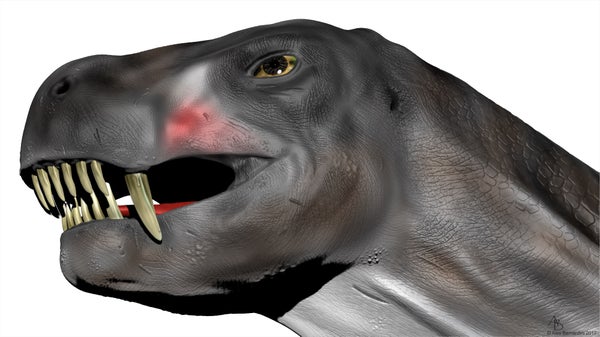This article was published in Scientific American’s former blog network and reflects the views of the author, not necessarily those of Scientific American
On supporting science journalism
If you're enjoying this article, consider supporting our award-winning journalism by subscribing. By purchasing a subscription you are helping to ensure the future of impactful stories about the discoveries and ideas shaping our world today.
Long, long ago, before the dawn of the dinosaurs, there lived a protomammal named Euchambersia mirabilis. This creature didn't call itself that, or likely any name at all, but that's how it's known to paleontologists. And as far as our ancient protomammal relatives go, Euchambersia is a bit of a celebrity. That's because it has long been thought to be the first vertebrate with a venomous bite.
The idea that this long-fanged synapsid from South Africa was venomous goes back to the eccentric paleontologist Franz Nopsca, who proposed the idea in 1933. Other experts have reinforced the conclusion since that time, pointing to a pit along the animal's snout and conspicuous grooves along the canine teeth - an anatomical pairing reminiscent of venomous snakes. But now paleontologist Julien Benoit and colleagues have challenged the popular hypothesis, drawing from high-definition CT scans to investigate whether Euchambersia really had a little something extra behind its bite.
Even though paleontologists have pointed to grooves on Euchambersia teeth as evidence of venom delivery since the 1980s, Benoit and coauthors point out, the actual teeth bear no such indentation. Quite the opposite - it seems that the teeth of Euchambersia are ridged.

A CT scan of Euchambersia, showing the positions of teeth from sockets in the jaw. Credit: Benoit et al. 2017
Nevertheless, the researchers found, Euchambersia has a set of curious characteristics. There's that indentation on the upper jaw, connected by a canal to the mouth, which could have delivered venom to those ridged teeth. Venom could have flowed from a gland housed in that maxillary fossa into the saliva of the mouth, the ridged teeth facilitating delivery of the dangerous substance during a bite.
Euchambersia might meet the three requirements for a venomous species, Benoit and colleagues write - a venom gland, a way to deliver the venom, and a way to make a wound for the venom to penetrate. If this idea holds, then Euchambersia retains its title for the earliest known venomous vertebrate and is a touchstone for the various other prehistoric species that have been called venomous on the basis of their osteology. But there's more than one way to look at all these features.
Even though the researchers state the venomous bite hypothesis is probably the best fit for Euchambersia, the same suite of features could be interpreted another way. Vertebrates from snakes to hippos have ridged teeth, adapted to everything from self-sharpening to holding onto slippery prey. Likewise, the indentation on the snout and the holes leading from it might indicate the presence of some hitherto unknown sensory organ.
"Because of the uniqueness of its skull anatomy," Benoit and coauthors conclude, "Euchambersia mirabilis is and will remain a puzzling species." There's plenty to study and debate, at least as far as anatomy can guide us. Hopefully, even though paleontology can be at times a contentious discipline, experts with be able to discuss the possibilities without venom.
Reference:
Benoit, J., Norton, L., Manger, P., Rubidge, B. 2017. Reappraisal of the envenoming capacity of Euchambersia mirabilis (Therapsida, Therocephalia) using μCT-scanning techniques. PLOS ONE. doi: 10.1371/journal.pone.0172047
